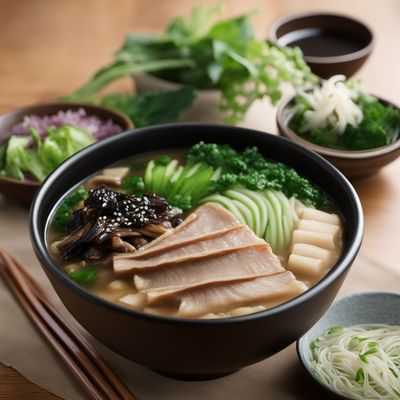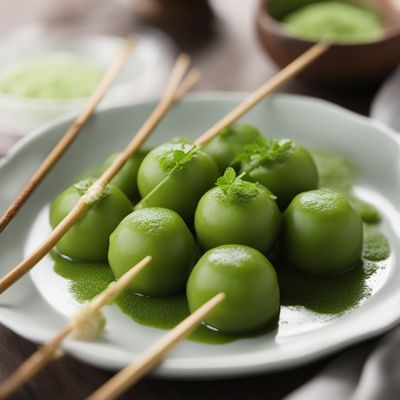
Recipe
Kiritanpo with a Nordic Twist
Nordic-Inspired Kiritanpo: A Wholesome Fusion of Japanese and Scandinavian Flavors
4.6 out of 5
This recipe combines the traditional Japanese dish, Kiritanpo, with the fresh and natural flavors of New Nordic cuisine. The result is a delightful fusion that showcases the best of both culinary traditions.
Metadata
Preparation time
30 minutes
Cooking time
20 minutes
Total time
50 minutes
Yields
4 servings
Preparation difficulty
Medium
Suitable for
Vegetarian, Vegan (if lingonberry sauce is made without honey), Dairy-free, Nut-free, Kosher
Allergens
Gluten
Not suitable for
Gluten-free (due to the use of barley and rye)
Ingredients
In this Nordic adaptation, we replace the traditional Japanese rice with a mixture of barley and rye, giving the kiritanpo a heartier and nuttier flavor. Additionally, we incorporate Nordic herbs like dill and thyme to enhance the dish's aroma and taste. The lingonberry sauce adds a tangy and sweet element, replacing the traditional soy-based dipping sauce. We alse have the original recipe for Kiritanpo, so you can check it out.
-
2 cups (400g) barley 2 cups (400g) barley
-
1 cup (200g) rye flour 1 cup (200g) rye flour
-
1 tablespoon dill, finely chopped 1 tablespoon dill, finely chopped
-
1 tablespoon thyme, finely chopped 1 tablespoon thyme, finely chopped
-
1 teaspoon salt 1 teaspoon salt
-
1 cup (240ml) water 1 cup (240ml) water
-
Lingonberry sauce: Lingonberry sauce:
-
1 cup (200g) lingonberries 1 cup (200g) lingonberries
-
2 tablespoons sugar 2 tablespoons sugar
-
1 tablespoon lemon juice 1 tablespoon lemon juice
Nutrition
- Calories (kcal / KJ): 320 kcal / 1340 KJ
- Fat (total, saturated): 1g, 0g
- Carbohydrates (total, sugars): 70g, 5g
- Protein: 8g
- Fiber: 12g
- Salt: 1g
Preparation
-
1.In a large bowl, combine the barley, rye flour, dill, thyme, and salt.
-
2.Gradually add water to the mixture, kneading until it forms a sticky dough.
-
3.Divide the dough into small portions and shape them into cylindrical logs around wooden skewers.
-
4.Grill the kiritanpo skewers over medium heat until golden brown and crispy, turning occasionally.
-
5.In a saucepan, combine the lingonberries, sugar, and lemon juice. Cook over low heat until the berries soften and release their juices, stirring occasionally.
-
6.Remove the kiritanpo skewers from the grill and serve with the lingonberry sauce.
Treat your ingredients with care...
- Barley — Make sure to cook the barley until it is tender but still slightly chewy. Overcooking may result in a mushy texture.
- Rye flour — Use a fine rye flour for a smoother dough consistency.
- Lingonberries — If fresh lingonberries are not available, you can use frozen ones. Adjust the sugar amount based on the sweetness of the berries.
Tips & Tricks
- To add a smoky flavor to the kiritanpo, you can grill them over charcoal instead of a gas grill.
- Experiment with different Nordic herbs like chives or lovage to personalize the flavor profile.
- Serve the kiritanpo with a side of pickled vegetables for a refreshing contrast.
Serving advice
Serve the Nordic-inspired kiritanpo as a main course accompanied by a fresh green salad. The lingonberry sauce can be drizzled over the skewers or served on the side for dipping.
Presentation advice
Arrange the grilled kiritanpo skewers on a rustic wooden platter, garnished with sprigs of fresh dill and thyme. Place a small bowl of lingonberry sauce in the center for dipping or drizzling.
More recipes...
For Kiritanpo
For Japanese cuisine » Browse all

Kinoko Nabe with Miso Broth
Umami Delight: Kinoko Nabe - A Mushroom Lover's Dream

Hiroshima-Style Okonomiyaki with a Twist
Savory Pancake Delight: Hiroshima-Style Okonomiyaki Reinvented

Jibachi Senbei - Japanese Honey Bee Rice Crackers
Buzzing Delights: Sweet and Crunchy Japanese Honey Bee Rice Crackers
More Japanese cuisine dishes » Browse all

Mizutaki Chicken
Mizutaki Chicken is a Japanese hot pot dish made with chicken and vegetables. It is a popular dish in Japan, especially during the winter months.

Tsukudani
Tsukudani is a Japanese dish that is made by simmering seafood, meat, or vegetables in soy sauce and sugar. The dish is typically served as a...

Tataki
Tataki is a traditional Japanese dish that involves searing fish or meat and serving it with a citrus-based sauce.





